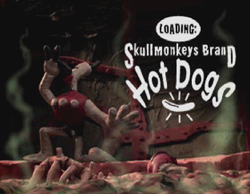 Skullmonkeys is notable for being a pretty fun videogame that, incidentally, hails form an alternate reality.
Skullmonkeys is notable for being a pretty fun videogame that, incidentally, hails form an alternate reality.
History is written by the winners, and, given enough time, even people who lived through that history tend to paper over the genuine details of reality. Case in point: the death of the 2-D platformer. To hear many of the old guard of videogames tell it, we spent the glorious 8 & 16-bit eras awash in an embarrassment of riches of 2-D platformers, and then, the moment the Playstation and N64 rolled into town, the era of 2-D was dead, presumably punched into an early grave by the sharp, polygonal fists of Battle Arena Toshinden. Sony had a legendary policy of rejecting all “childish” 2-D games, and the N64 couldn’t render a “retro” sprite to save its cursed life. 2-D died, and the Buster Sword was the murder weapon.
Except that’s complete bullshit, because there certainly were 2-D games on the Playstation. One of the most lauded games of all time was released on the Playstation, and it was 2-D. Mega Men of various origins had a number of 2-D adventures through the 32-bit era, and Playstation even paid host to many underdog 2-D adventures, like Silhouette Mirage and Norse by Norsewest. In short, while 3-D certainly dominated the epoch (for every Symphony of the Night there was a Castlevania 64… maybe even two) there were also 2-D action games available on CD and cartridge straight through to the death of the age of DVD. Yes, Mega Man 9 was a retro innovation, but it wasn’t that far removed from Mega Man X8.
So if 2-D games did exist, then where did they go? No, I don’t mean, “where did they end up?” We can see the answer to that every time we check the 3DS’s eshop and encounter a variety of platformers wallowing in the “Under $10!” ghetto. What I’m referring to is evolution. What I’m talking about is Mario, and the enormous gulf between Super Mario Bros. and Super Mario World. Heck, we consider Super Mario Bros. 3 and Super Mario World to be roughly contemporary, but Mario Maker reminded everyone that the difference between 8 and 16-bits is a lot more than eight digits. But that’s just how videogames worked practically since their inception: a new system with new possibilities means all the old games you remember with all-new graphical upgrades to get with the times. Super Contra, Super Castlevania, Super Adventure Island, Super Alfred Chicken. It’s a brand new day, and it’s time to see just how many pixels we can dedicate to Link’s eyebrows.
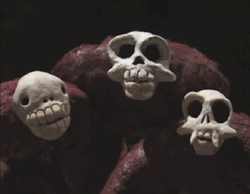 Of course, I suppose it’s Link and Mario that killed that trend. Mario 64 and Ocarina of Time destroyed the idea of the “evolving” sprites. Now Sonic would have to have an adventure, Mega Man would have to be a legend, and anybody that wanted to stick to the 2-D universe (hi, Wario!) would have to retreat to the lesser, portable systems. It would be years before we saw an updated Master Higgins or Monster World, because it was time to permanently migrate over to 3-D pastures.
Of course, I suppose it’s Link and Mario that killed that trend. Mario 64 and Ocarina of Time destroyed the idea of the “evolving” sprites. Now Sonic would have to have an adventure, Mega Man would have to be a legend, and anybody that wanted to stick to the 2-D universe (hi, Wario!) would have to retreat to the lesser, portable systems. It would be years before we saw an updated Master Higgins or Monster World, because it was time to permanently migrate over to 3-D pastures.
But 3-D was not the welcoming land of milk and honey that many expected. The mascot platformer had ruled the 16-bit world, and, while many were happy to see that trend die kicking and screaming, it was clear that a universe of polygons was not going to do “cute characters” any favors. Many believe Sonic conquering the consoles fast is the only reason we saw the rise of the generic furry with attitude, but it’s a lot more likely that the horsepower of the Super Nintendo and Sega Genesis simply allowed for more expressive and “interesting” (I’m using quotes specifically for Aero the Acro-Bat there) mascots. And the Playstation could certainly create characters with a greater range of expressions than on the old systems… but nobody was going to mistake a model full of angles and sharp edges for cute. In fact, the death of Bubsy and his furry friends was probably just because no one could properly render fur. And without fur, all you’ve got is a ry.
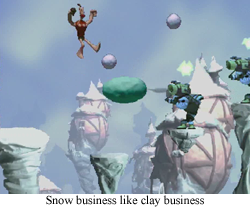 But there was one mascot from the 16-bit era that didn’t possess a single tuft of fur: Earthworm Jim. EWJ was the 16-bit mascot ideal: he was the cover-worm for every videogame magazine, he starred in his own animated series, and everyone fought over which version of which game was truly the best of the bunch. EWJ was a full-fledged phenomenon… for all of ten minutes. But, one-hit wonder or no, shouldn’t the ol’ powersuit have made the transition to 3-D? Where did our invertebrate hero go? Or, more particularly, where did the people who birthed Earthworm Jim go?
But there was one mascot from the 16-bit era that didn’t possess a single tuft of fur: Earthworm Jim. EWJ was the 16-bit mascot ideal: he was the cover-worm for every videogame magazine, he starred in his own animated series, and everyone fought over which version of which game was truly the best of the bunch. EWJ was a full-fledged phenomenon… for all of ten minutes. But, one-hit wonder or no, shouldn’t the ol’ powersuit have made the transition to 3-D? Where did our invertebrate hero go? Or, more particularly, where did the people who birthed Earthworm Jim go?
Well, they went to the Neverhood. Doug TenNapel created Earthworm Jim, and he left Shiny Entertainment (with a number of other employees) in 1995, likely because everyone seems to think Dave Perry invented the previously mentioned groovy guy. The Neverhood Inc (company) then partnered up with Dreamworks to create The Neverhood (game), an adventure game with a sincere/crazy sense of humor/whimsy. It was also a game where everything was made of clay, and there may or may not have been a hallway of scribbles that took about seventeen hours to read. It… was a weird game. But it was fun! And funny! And if PC gaming wasn’t a living hell at the time, The Neverhood likely would have become a game just as legendary as Earthworm Jim. Unfortunately, this was also a time when Electronics Boutique stopped selling PC games entirely because it was getting fed up with having to accept constant returns from screaming customers that never seemed to be able to purchase a game that would actually run on their own computers, so The Neverhood fell into that limbo of “great game, but only six people ever played it” like many 90’s computer games.
So, naturally, Neverhood Inc. tried to get a piece of the console pie. Wisely, Neverhood Inc. realized that the King’s Quest-esque adventure genre wouldn’t work on consoles for another decade or so, so the Neverhood world was repurposed as a more console friendly platforming game. Skullmonkeys was born.
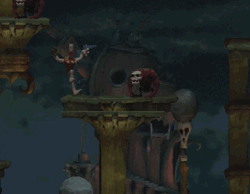 Skullmonkeys is a platforming game, plain and simple. You run, you jump, you jump on enemies, you spend a lot of time waiting for moving platforms, you’re dead in one hit unless you grab a powerup that allows for two hits, and there are a few “fireball” bits of ammo scattered around for when jumping just won’t do it. There’s a simple progression of difficulty and an increasing number of “traps” as Klaymen ventures through Idznak. There are bosses with simple, repeating patterns. There are bonus stages available only through finding various hidden knickknacks. It’s a platforming game, and if you switched in Bubsy or Awesome Possum for Klaymen, nobody would blink an eye. … Well, aside from the general confusion that would arise from playing a Bubsy game that was actually good.
Skullmonkeys is a platforming game, plain and simple. You run, you jump, you jump on enemies, you spend a lot of time waiting for moving platforms, you’re dead in one hit unless you grab a powerup that allows for two hits, and there are a few “fireball” bits of ammo scattered around for when jumping just won’t do it. There’s a simple progression of difficulty and an increasing number of “traps” as Klaymen ventures through Idznak. There are bosses with simple, repeating patterns. There are bonus stages available only through finding various hidden knickknacks. It’s a platforming game, and if you switched in Bubsy or Awesome Possum for Klaymen, nobody would blink an eye. … Well, aside from the general confusion that would arise from playing a Bubsy game that was actually good.
Except… this was a game on the Playstation. There weren’t platforming games on the Playstation, and there certainly weren’t games that looked this gorgeous. Skullmonkeys was released the same year as Resident Evil 2 and Metal Gear Solid, 3-D games that are marvelous, wonderful experiences that are also, incidentally, terrible to look at. No, Skullmonkeys must be the last vestige of an alternate universe, another timeline where platforming games were allowed to evolve and grow into their “next gen” forms. This gorgeous, but limited, platforming game could not have seriously been released the same year as Spyro the Dragon. 1998 games are supposed to be polygons for days, with FMVs like you’d find in Ehrgeiz. There weren’t playforming games like this on the Playstation!
History tells us that platforming died with the last gasp of the Super Nintendo. Skullmonkeys, clearly, never happened.
More’s the pity.
FGC #294 Skullmonkeys
- Platform: Playstation. I do not believe this has been ported anywhere else. This is what happens when a game is imaginary.
- Number of players: Just Klaymen. I would not have said no to Willie becoming the Luigi.
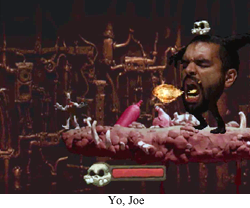 Favorite Boss: Joe Head Joe has Joe’s head for a body. At least, I would assume that is Joe. If not, he is pretty poorly named.
Favorite Boss: Joe Head Joe has Joe’s head for a body. At least, I would assume that is Joe. If not, he is pretty poorly named.- Pedantry Corner: Yes, I know there was a 3-D Earthworm Jim game. No, I am not ever going to acknowledge it.
- Sequel Story: Skullmonkeys is a direct sequel to Neverhood, picking up exactly where the good ending of Neverhood left off, and including the planet Idznak, which was mentioned in that long-ass hallway. Fortunately, you don’t need to know a blessed thing from the Neverhood to enjoy this game, as “Klogg is evil” seems pretty apparent from the first moment he skins a monkey and wears his skull as a hat.
- Just play the gig, man: The bonus stage music is delightful, and I certainly do not jump every time the singer claims there’s a monster right behind me.
- Secret Shame: I have never seen the 1970’s bonus stage. Where are those damn things hiding!?
- Goggle Bob Fact: There was enough advertising for Skullmonkeys that a Skullmonkeys sticker wound up stuck to my locker freshman year. For some reason, I found this act rebellious. I was a troubled youth.
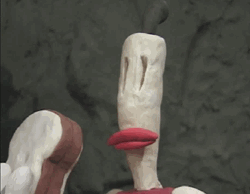 Did you know? There was apparently a Japan-only “sequel” to the Neverhood universe, a sports game called Klaymen Gun-Hockey. It was created by the company that had the Japanese rights to localize Neverhood games, and… was probably insane.
Did you know? There was apparently a Japan-only “sequel” to the Neverhood universe, a sports game called Klaymen Gun-Hockey. It was created by the company that had the Japanese rights to localize Neverhood games, and… was probably insane.- Would I play again: Probably yes. This is a genuinely good platforming game, and I’d love to see it available on a portable (not phone, we need buttons here) system. Assuming we ever see that, couple it with save states, and we’re golden.
What’s next? Random ROB has chosen… Sunset Riders for the Super Nintendo! Get ready to bust some outlaws, pardner. Please look forward to it, ya’all!

The Neverhood series has such a great art style; I would’ve gladly bought Armikrög if Doug hadn’t become such a horrible white supremacist asshole and I didn’t want to give him money again ever. *sigh*
But yeah, it’s definitely a shame we don’t see more 2D platformers like Skullmonkeys, or high quality 2D games in general. I’m still a li’l bitter…well, very bitter that Sony’s policies and the stupid 3D Roolz/2D Droolz attitude pushed by idiots likely played some part in cheating us out of some of the most creative games of the era.
…Aw who am I kidding? Moon: Remix RPG and the old Oreshika would’ve always have been a hard sell in the 90s, 2D or no.
[…] you know? The animators for Genesis Park (including Doug TenNapel) studied real, live lizards to properly animate the dinosaurs that would inevitably devour poor […]